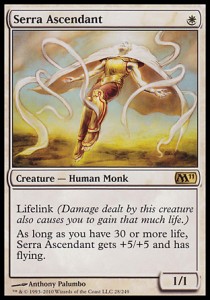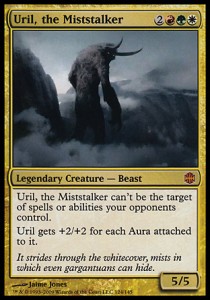I was listening to Limited Resources the other day when Marshall, the host, posed an interesting question: “How much life would a 1 drop sorcery have to give you before you’d pick it over a Serra Angel?” It’s an interesting question. Lifegain cards are often bandied about in Limited drafting circles as “newbie traps.” Gaining a chunk of life seems attractive at first, but the fact that you’re not actively advancing your board state most often means that you quickly end up taking more damage than you gained in the first place. Marshall and Jon started tossing out numbers like, 10, 15, or even 20 life, but when it came down to it, neither one of them was really comfortable taking a card that did nothing to advance the board state over an archetypical board-dominating creature.

What does drafting have to do with EDH, you ask? Well, consider this question: how big would a vanilla creature have to be before it was worth playing in EDH? Let’s even be generous and call it a one-drop. 5/5? 6/6? 10/10? Given the somewhat undeserved popularity of [card]Serra Ascendant[/card], I imagine most people would answer somewhere north of 6/6. Myself, though, I find myself in the same dilemma as Marshall and Jon with their theoretical lifegain card. I suppose a one-drop vanilla 10/10 would be pretty good, but I still wouldn’t feel good playing it. Sure, in something like 1/10th of my games I’d be able to cast it and put an opponent on a 4 turn clock on turn one, and in maybe a third of those games I’d actually kill them with i. In most other games I’d play it, it might get chumped a turn or two, and then it will get wrathed away or otherwise dealt with, leaving me with very little net benefit.
What it comes down to is that EDH is a format that is fundamentally hostile toward the traditional concept of aggro. If your game plan is to just play a series of efficiently costed creatures and burn spells, you’re essentially throwing away cards for damage. In a two-player 20-life game, you only need to get about 3 damage out of each nonland card that you play in order to kill someone by turn 4 or so. In a 40 life format with multiple players, you need to get an average of 6 life per player out of each one of your cards in order to win in the same time frame. That means games are going to go long, so all those efficient small creatures you’ve been playing on turns 1-4 are going to quickly get either wrathed away or completely outclassed by their 5, 6, and 7 drops.
Even when you do have a one drop creature that can compete with late game creatures like [card]Serra Ascendant[/card], they still aren’t able to kill someone on their own before that person’s defenses come online. Sure, it might be able to trade for a fatty or removal spell, but in the end both you and the person you traded with are down a card and they’re down some life. The rest of the table is unscathed, and you have a huge target on your head. All in all, you have definitely come out behind in that exchange.
The lesson in all of this is that in EDH, It’s not enough to just play efficiently costed creatures, turn them sideways, and expect to do well. Your creatures need to do something. Take a quick look at some of the best creatures in EDH: [card]Terastodon[/card], [card]Avatar of Woe[/card], [card]Sun Titan[/card], [card]Consecrated Sphinx[/card], and [card]Steel Hellkite[/card]. What do they all have in common? Each is not only a powerful, efficiently costed creature, they also help disrupt your opponent or generate card advantage for yourself. By being able to disrupt your opponents and keep your hand full while you advance your own board, you can maintain momentum and continue to make relevant plays throughout the entire game.

Now, all that is fine and good when you’re building a deck that looks to parry and thrust and eventually crush its opponents under the weight of its card advantage, but what if you really just want to bash face? Well, while traditional aggro is terrible in EDH, that doesn’t mean that extremely powerful aggro strategies don’t exist. They just look very different than their constructed counterparts. There are two main schools of aggro deck design: voltron and tokens. A voltron deck attempts to get around the problems that high life totals cause aggro strategies by relying on its general to deal just 21 damage to each opponent. These decks tend to be filled with powerful auras, equipment, disruption, and a smattering of creatures picked more for the abilities they bring to the table than their size. Token decks get around the problems of high life totals by generating large amounts of creature tokens and then taking advantage of the massive scaling power of effects that pump their team to swing in for huge amounts of damage. Now, if both of these strategies sound somewhat like a combo, you’d be right. It just shows that in order to survive in a format as hostile as EDH, successful aggro decks need to exploit massive amounts of synergy in order to keep up.
6 responses to “EDH Deckbuilding Fundamentals: Creature Theory and the Problem of Aggro”
A poster on Facebook asked: “So what is your opinion on poison counters and EDH? Is it ok at 10 in that it actually makes a more traditional aggro strategy viable or do you think it should be bumped up like in Two-Headed Giant?”
Poison as an aggro strategy still isn’t viable. Poison creatures are undersized, so you’re really not getting as much mileage out of your creatures as you think. Furthermore, the variance inherent in a 99 card deck means that you’re almost never going to get that T1 Glistener Elf, T2 poison dude that you really need. Tutors can help your consistency, but they also slow you down. A T3 or T4 infect creature isn’t nearly as threatening as one on T1.
What it comes down to is that in order to reliably poison people, you need to embrace some kind of synergy. Either you voltron it up with Grafted Exoskeleton, Skitheryx, or Hatred, or you get in a couple poison on each player and proliferate them to death. Neither strategy is really aggro in the traditional sense.
As for whether 10, 15, or 20 is the right number for EDH, I think 10 is fine. Yes, you can pull off some easy wins at 10 with Grafted Exoskeleton, but that isn’t really any different than any other instant-win combo. Pushing the total up to 20 just to make an instant-win combo more difficult doesn’t seem like all that compelling of a reason.
Great article Coda. EDH deckbuilding still befuddles me but I’m getting better. I’ve realized the whole thing is a giant puzzle. Building to a particular General is a puzzle, building to a particular meta-game is a puzzle, even piloting the deck is a puzzle. Right now Jor Kadeen is my puzzle. I started out on him making the exact mistakes you’ve illustraed up above. All my favorite R and W aggressive creatures shoved in the deck. Then I did some research, looked at others’ builds of him and I’ve been playing with both the voltron and token army strategies you’ve discussed here.
The builds I’ve gone through have all seemed good on paper, but then in action I came up against problems I hadn’t anticipated. The reality is there is a pretty powerful EDH metagame in Portland. Probably not the easiest city to start in, but shortens the learning curve. So I’m still working on the puzzle of adapting my list to the meta.
The third puzzle, of how best to pilot the deck is part of my growth as a magic player. I played a two-headed giant game alongside Terry last week and his ideas of things to do with my deck during the game was awesome. No better way to learn to play EDH than 2H Giant.
Anyways, since your posts are somewhat aimed at new players, thought I’d respond as a new player. I also realize Jor isn’t a great beginner’s general, but I like him. I really believe the first rule of magic ought to be ‘play what you like’. It’s why I quickly abandoned any thoughts of Standard.
See you at a game soon.
David
I have an interesting counter point to this article.
Sometimes I play a mono red goblin aggro deck in 4 player EDH games, I don’t think I’ve ever won, but I usually have a lot of fun, and manage to kill someone off.
So, while aggro is far from viable as a winning strategy, it can be a blast to play, which is why I play EDH. As long as you don’t try too hard to win, and don’t get too butthurt when someone plays [card]Wrath of God[/card], they I say go for it! Aggro it up friends 😀
This is a nice article, but the Token decks didn’t really get too much shine here, there’s so many different types of token decks. Sekki, Season’s Guide from Saviors of Kamigawa is a great way to pump out tokens, especially if a Doubling Season and/or Parallel Lives is on your field. With him, it’s possible to just generate any number of tokens with him in a turn. Then there’s a Blue/Green Mycoloth/Paradox Haze combination with another PL or DS combination.
Not to sound biased, but Token decks (for myself) seem to be the most effective and fun EDH decks to play, only because there’s so much you can do with them and with the different types of token generations (Zombies, Saprolings, Eldrazi Spawn, Soldiers, Cats, Pegasus, Birds, Angels, etc.) There’s no end to the different strategies that a single token deck can adapt to.
And I do agree with Samwise, EDH is just fun to play and that’s the whole point of the game. But it’s also fun to have a deck that can adapt to different plays and players and not go by the same ritualistic strategy each and every time.
Token decks can definitely be extremely powerful. In fact, the most oppressively powerful deck I’ve ever built was a token deck (Asuza, for those who are wondering). A big part of their power is the fact that they really don’t care what you have on the board. 2/2s, 1/1s, 0/1s, whatever, you just need a critical mass of warm bodies and a force-multiplier card like Overwhelming Stampede or Hit//Run. That said, I wasn’t trying to give tokens an in-depth analysis here. I was just explaining exactly why a force-multiplying strategy like tokens was necessary if you want to pull of an aggro deck in EDH. I’m sure sometime in the future I’ll write another article that focuses on the anatomy of a token deck, though. Stay tuned.
i agreee; play what u like